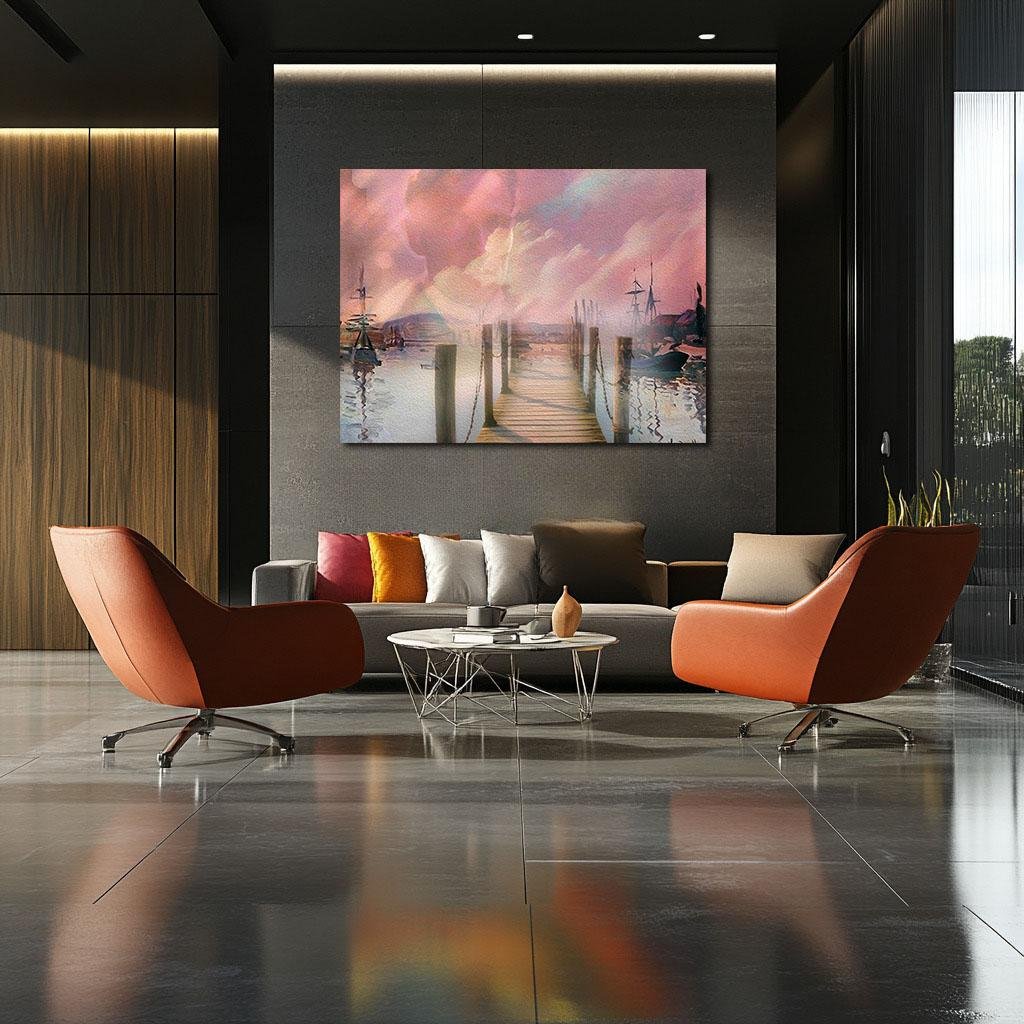The Stillness Between Currents: The Seine Downstream from Rouen Reimagined
The Stillness Between Currents: The Seine Downstream from Rouen Reimagined transforms Monet’s gentle river view into a contemplative, dreamlike landscape where a wooden dock leads into mist and memory. Ghostly boats float beside calm waters as a translucent portrait gazes inward from the clouds above. The piece merges portrait and landscape into a quiet meditation on presence, longing, and emotional passage. With tones of lavender, rose, and golden dusk, this reinterpretation invites the viewer not to travel, but to pause—to dwell in the stillness where reflection becomes the truest form of movement.
Please see Below for Details…
Hotline Order:
Mon - Fri: 07AM - 06PM
404-872-4663
Claude Monet’s The Seine downstream from Rouen , likely painted during the early 1870s, represents a subtle meditation on space and light, a moment suspended in quiet observation. With soft reflections, distant boats, and gentle tonal transitions, the work explores the delicate tension between water and atmosphere, between movement and rest. In this conceptual reinterpretation, titled The Stillness Between Currents: The Seine Downstream from Rouen Reimagined , Monet’s river becomes a place of inward crossing, a dreamlike portal where landscape and portrait converge. The scene unfolds not just as a passage of water but as a passage of self—where memory, presence, and emotion blur like reflections at dusk.
At the center of the piece, a wooden dock extends into the mist, its planks weathered but sure, suspended between still water and vanishing sky. Chains hang gently between posts, soft in their weight, guiding the viewer’s gaze not toward a destination, but into the unknown. This jetty is not a structure of travel—it is a structure of surrender. It leads forward, yet the path ahead dissolves into haze. Nothing is fixed. Everything is invitation.
On both sides of the dock, the river expands in soft lavender and rose, tinged by golden undertones that suggest the final moments of light. Boats float quietly, anchored but alert, their masts thin silhouettes against the pastel sky. Some are distant, mere ghosts in the fog, while others lean toward the dock, as if listening. Their sails are lowered, their labor paused. They are at rest, not because the journey has ended, but because reflection is now the purpose.
In the background, the far banks of the Seine curve gently, almost imperceptibly, offering only the faintest suggestion of a town, of land, of permanence. Trees blur into rooftops, chimneys dissolve into sky. The horizon becomes a mirror—one that refuses to separate above from below, thought from feeling.
Overlaying the entire composition is the translucent presence of a man’s face—softly defined, almost blending into the clouds. His expression is solemn, yet peaceful. His gaze, downward and inward, reflects the very nature of the dock below him. He is not observing the scene. He is part of it. His portrait is not painted with edges, but with light, tone, and memory. He is a reflection not just on the water, but in it. A remembered presence. A soul adrift in thought, tethered only by the suggestion of longing.
This figure does not demand interpretation. He evokes remembrance—perhaps of someone once loved, or of the part of the self that remains in stillness when all else has moved on. He belongs not to the physical world but to the emotional tide of the piece, shaping the landscape not through action, but through presence. His placement in the sky suggests a merging with the elements—his breath in the clouds, his silence in the river’s reflection, his memory in every shadow that stretches across the dock.
The color palette of this work is its quiet language. Rose, lavender, faded mauve, and dusty amber roll softly across the sky and water, blurring all distinctions between physical form and emotional resonance. These hues are not bold. They do not shout. They whisper, echo, pause. They allow space for interpretation, for feeling, for stillness.
The light in this piece is not directional. It radiates from within the composition, from the face, from the water, from the moment itself. It is not morning or evening. It is memory light. The kind that comes in recollection or dream. The kind that does not reveal the world, but reveals how one feels in it.
As the artist, I approached this reinterpretation as a meditation on pause. Monet painted the Seine as a study of atmosphere. I sought to deepen that by creating a space where the river becomes a psychological and spiritual threshold. The dock is the self, the water is memory, and the portrait above is the soul we carry within, always watching, always drifting.
The Stillness Between Currents is not about the journey down the river. It is about the moment we stop rowing. The moment we listen. The moment we allow ourselves to dissolve into light, into reflection, into presence.
Add your review
Your email address will not be published. Required fields are marked *
Please login to write review!
Looks like there are no reviews yet.








